Behind AFP's Syria coverage
Nicosia -- Every day, dozens of photos taken by stringers in Syria land at the photo editing desk in Nicosia, AFP’s headquarters for the Middle East and North Africa. Sometimes, we get hundreds. Like on March 13, when we got 350. It’s been like this for years.
On March 15, the Syrian conflict entered its eighth year. Since the beginning, AFP has been one of the very few international outlets to maintain constant on-the-ground coverage. To pull this off, we have a network of stringers that we built over the course of several years. This is probably unequalled among major foreign media outlets.
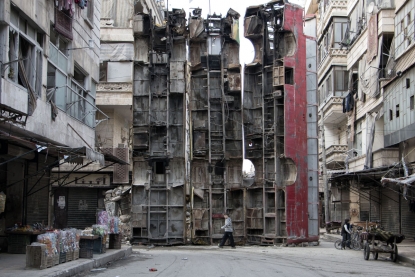 A young boy walks past a makeshift barricade made of wreckages of buses to obstruct the view of regime snipers and to keep people safe, on March 14, 2015 in the rebel-held side of the northern Syrian city of Aleppo. (AFP / Karam Al-masri)
A young boy walks past a makeshift barricade made of wreckages of buses to obstruct the view of regime snipers and to keep people safe, on March 14, 2015 in the rebel-held side of the northern Syrian city of Aleppo. (AFP / Karam Al-masri)It all began in 2013, when it became clear that foreign journalists were becoming major targets for jihadists and various gangs. With the increase of kidnappings in rebel-held areas, it was no longer a realistic option to continue sending reporters there, only for them to become hostages (or worse).
But that meant that we risked not having information or images from the region and that we would only be able to cover one side of the conflict -- the regime’s -- since AFP has had a bureau in Damascus for years. So we decided to start working with “citizen journalists,” young Syrians who wanted to show what was going on in their country and, to do so, published their photos on social media.
The determining element was a photo workshop, which took place in June 2013 in Turkey for about 15 of these “citizen journalists.” They came from Aleppo, Deir Ezzor, Idlib and even Raqqa to work with an AFP photographer. None of these young Syrians knew anything about photography, let alone photojournalism, but that’s where it all began.
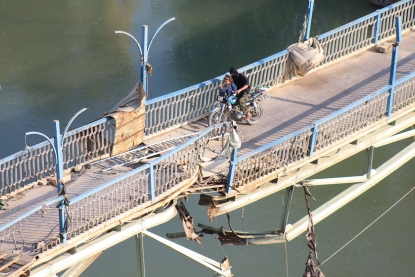 A rebel fighter and a child cross a damaged bridge in Syria's eastern town of Deir Ezzor, on September 2, 2013. (AFP / Abo Shuja)
A rebel fighter and a child cross a damaged bridge in Syria's eastern town of Deir Ezzor, on September 2, 2013. (AFP / Abo Shuja)In the following weeks, about 10 of them began to send us photos, mostly under pseudonyms. Only a few of them kept working with us in a sustainable way. Some of them left the country or were killed. But then more arrived.
Finding these stringers was the easiest part of the job. We then had to train them remotely, to teach them what a photo was and, more importantly, what journalism was and how we at AFP worked. Our mission is to inform, not to take sides. We never doubted for a minute that these stringers had their own opinions, often firmly held ones. Some still express them on social media.
 A cow is seen attached to scrap metal near destroyed buildings in Douma, in the rebel enclave of Eastern Ghouta on the outskirts of Damascus on March 12, 2018. (AFP / Hasan Mohamed)
A cow is seen attached to scrap metal near destroyed buildings in Douma, in the rebel enclave of Eastern Ghouta on the outskirts of Damascus on March 12, 2018. (AFP / Hasan Mohamed)But the main thing was for us to be able to avoid any manipulation and to assure ourselves that the photos coming from Syria met AFP standards, to know that, besides their aesthetic value, they faithfully recounted the situation on the ground and the impact of the conflict, in addition to their aesthetic qualities.
Today, the standards for accuracy and impartiality haven’t changed. They continue to motivate the eight people on the photo desk and their six colleagues in video. Every day, they take turns editing, verifying, and authenticating every photo and video that we publish. It’s a process that’s as long and tedious as it is essential.
 Syrian men carrying babies make their way through the rubble of destroyed buildings following a reported air strike on the rebel-held Salihin neighbourhood of the northern city of Aleppo, on September 11, 2016. (AFP / Ameer Alhalbi)
Syrian men carrying babies make their way through the rubble of destroyed buildings following a reported air strike on the rebel-held Salihin neighbourhood of the northern city of Aleppo, on September 11, 2016. (AFP / Ameer Alhalbi)It’s just as punishing on a psychological level, since many images show an unbearable kind of violence, especially the photos of children. Our photo and video editors still have to examine them to determine how newsworthy they are, and to decide which can be used. It’s a thankless task that can rattle even the most stoic person and poses the risk of psychological problems. Post-traumatic stress is a growing danger at editing desks like ours. The editors who support the stringers are truly the unsung heroes in this type of coverage.
 Photo editing desk in Nicosia, March 14, 2018.
(D.R.)
Photo editing desk in Nicosia, March 14, 2018.
(D.R.)The photos are sent via email, but our correspondents need an internet connection for that, which can be challenging. Then the verification process begins.
For each shot, we have to verify the metadata, which shows the date it was taken and the equipment used, meaning the camera or the lens. We have equipment lists for all our stringers, so it’s easy to verify that the photo was taken with their gear. If the equipment doesn’t match up, which inevitably happens because of the bombings and ensuing damage, we contact the photographer in question over WhatsApp for an explanation.
Verifying a photo’s location can’t be done with metadata. In the case of Eastern Ghouta, the task is simple. Our stringers are in a zone under siege from the Syrian army and its allies, and they can't leave. So we know where they are. It was the same at the end of 2016 during the endless siege on the eastern part of Aleppo.
If there’s no metadata, we don’t use the photo. Instead, we ask the photographer to resend it, even if it’s someone we know and trust. When you take communication problems into account, publishing a photo can be delayed by several hours, or even pushed until the next day. Accuracy comes at a price.
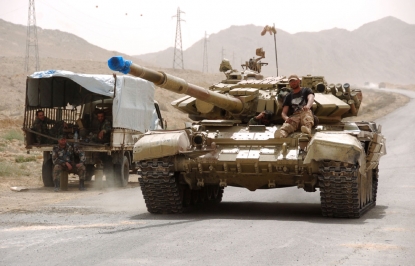 Syrian pro-governement forces drive a tank on the outskirts of Palmyra on March 25, 2016, during a military operation to retake the ancient city from the jihadist Islamic State (IS) group. (AFP / Stringer)
Syrian pro-governement forces drive a tank on the outskirts of Palmyra on March 25, 2016, during a military operation to retake the ancient city from the jihadist Islamic State (IS) group. (AFP / Stringer)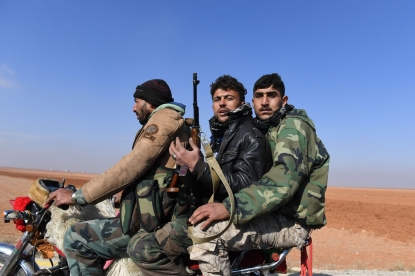 Members of the Syrian government forces drive a motorbike in the village of al-Hajib, near Jabal al-Hass, in the southern part of Aleppo province on January 14, 2018. (AFP / George Ourfalian)
Members of the Syrian government forces drive a motorbike in the village of al-Hajib, near Jabal al-Hass, in the southern part of Aleppo province on January 14, 2018. (AFP / George Ourfalian)
In other situations, we match the information in photos or videos with our text stories before verifying that it corresponds and that the images were indeed taken in the place indicated by the photographer or photojournalist. We can also use Google Maps to identify certain landmarks that show us if it’s the right place.
If we’re unsure about a photo that seems really interesting, but that we can’t authenticate, we can still use the photo lab in Paris, or even resort to a very sophisticated software called TunGstene. AFP is one of the few media outlets that has it. In 2011, we were able to use this software to disprove a photo supposedly showing Bin Laden after he had been killed by “Navy Seals.”
To say that it's not possible to verify or authenticate the images coming out of Syria is, as far as AFP is concerned, not only untrue, but also absurd. You just have to be willing to do it and to give yourself the human and technical resources to do so.
Graphic image
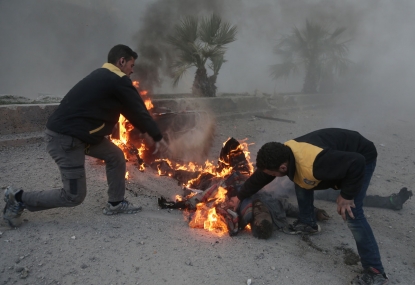 Syrian civil defence volunteers try to put out a fire engulfing a man fatally wounded in the bombardment of the rebel-held town of Hamouria, in the besieged Eastern Ghouta region on the outskirts of the capital Damascus, on March 7, 2018. (AFP / Abdulmonam Eassa)
Syrian civil defence volunteers try to put out a fire engulfing a man fatally wounded in the bombardment of the rebel-held town of Hamouria, in the besieged Eastern Ghouta region on the outskirts of the capital Damascus, on March 7, 2018. (AFP / Abdulmonam Eassa)
We don’t publish all the images we get from Syria -- far from it. On March 13, for example, we only published 161 photos out of the 350 that we received. We only distribute the ones that have real news value while still meeting the required aesthetic standards. We therefore eliminate the most gruesome photos. And unfortunately, there are a lot of those. The same goes for video.
The goal is not to shock or sensationalize, but to inform. And that means to show, within certain limits, the impact of the conflict on people who live in rebel zones or regime-controlled areas. Not to do so would amount to taking away the victims’ humanity. It would put them on the same level as simple statistics (“127 dead Monday in Eastern Ghouta”), as if we were handling a report on road casualties after a long weekend.
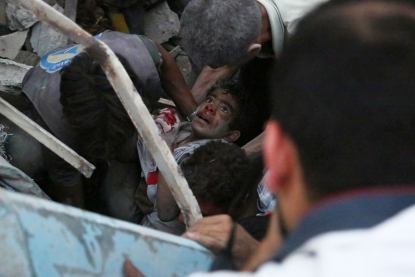 Syrians evacuate an injured boy from rubble following a reported air strike on a rebel-held town of Douma, northeast of the capital Damascus on June 16, 2015. (AFP / Sameer Al-doumy)
Syrians evacuate an injured boy from rubble following a reported air strike on a rebel-held town of Douma, northeast of the capital Damascus on June 16, 2015. (AFP / Sameer Al-doumy)It’s these stringers who, for years, have let us keep a window open on this unending war. There are a lot of images from Syria circulating on social media that get picked up by press outlets. But unlike the ones published by AFP, those photos aren’t verified or authenticated. Authentication is the biggest challenge for outlets that cover Syria. It’s the first conflict that has posed this problem on such a huge scale. Our stringer network allows us to offer clients our own product, stamped “AFP.”
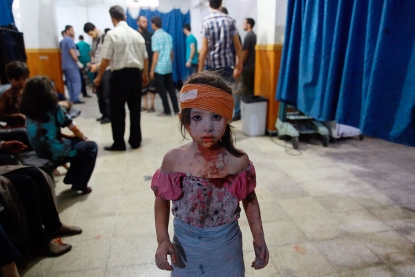 A wounded Syrian girl looks on at a make shift hospital in the rebel-held area of Douma, east of the capital Damascus, following shelling and air raids by Syrian government forces on August 22, 2015. (AFP / Abd Doumany)
A wounded Syrian girl looks on at a make shift hospital in the rebel-held area of Douma, east of the capital Damascus, following shelling and air raids by Syrian government forces on August 22, 2015. (AFP / Abd Doumany)Since the assault on Eastern Ghouta began on February 18 for instance, we have published almost 70 videos shot by local correspondents.
The stringer network grew gradually at first, with new stringers replacing the ones who left. Some correspondents started working on video and text pieces, under the direction of the Beirut bureau, which brilliantly manages Syria coverage and daily guidance for stringers.
Our relationships with some of these stringers have grown past the strictly professional level. Over the years, the journalists in Beirut and the photo and video editors have been a vital source of psychological support for these young Syrians, who are cut off from the world and confronted daily with bombings, famine, and death. They talk to them throughout the night on WhatsApp, encouraging them and keeping their spirits up. Some journalists in Beirut or on the photo desk in Nicosia have become de facto confidants, therapists, and friends to these stringers. The most surprising thing is that this happened even though they had never met.
In addition to fulfilling our duty to inform, one of AFP’s biggest accomplishments was helping to form and develop a generation of young journalists who are well-educated in the values of balance and rigor that are fundamental to AFP’s work. These values are even outlined in our two ethics charters, which are also available in Arabic.
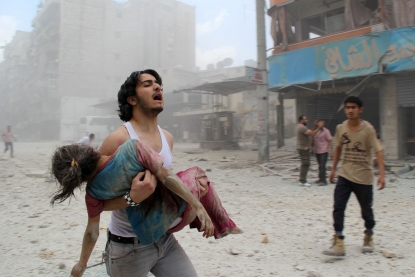 A man carries a young girl who was injured in a reported barrel-bomb attack by government forces on June 3, 2014 in Kallaseh district in the northern city of Aleppo. (AFP / Baraa Al-halabi)
A man carries a young girl who was injured in a reported barrel-bomb attack by government forces on June 3, 2014 in Kallaseh district in the northern city of Aleppo. (AFP / Baraa Al-halabi)It was not initially obvious this would happen when everything began back in 2013. Since then, though, many of our stringers have been rewarded for their talent and professionalism with prestigious international photo and video prizes, like Karam Al-Masri, Abd Doumany, Ameer Al-Halbi or Zein Al-Rifai.
At the same time, we never stopped covering “the other side” -- that of the regime, where the images are not as tragic but people still suffered from the effects of the war. Rebel rockets from Eastern Ghouta regularly strike neighborhoods in Damascus.
One of the most beautiful moments from these terrible years occurred when our last correspondent on the ground managed to leave the eastern part of Aleppo on December 19, 2016, just before it was retaken by the Syrian army. He’s now been given refuge in France. One of our stringers in the government-held areas sent him a message on learning he was safe. Calling him “brother,” he said he hoped they would meet one day “in a country healed from the war.” The message ended with these words: “This war isn’t ours...We’re just burning leaves.”
This blog was translated from the French by Tori Otten.
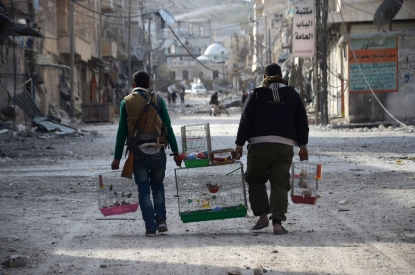 Syrian rebels carry birds in cages in the northwestern border town of al-Bab on February 24, 2017 after Turkish-backed rebels announced the recapture of the town from the Islamic State (IS) group a day earlier. (AFP / Nazeer Al-khatib)
Syrian rebels carry birds in cages in the northwestern border town of al-Bab on February 24, 2017 after Turkish-backed rebels announced the recapture of the town from the Islamic State (IS) group a day earlier. (AFP / Nazeer Al-khatib)





